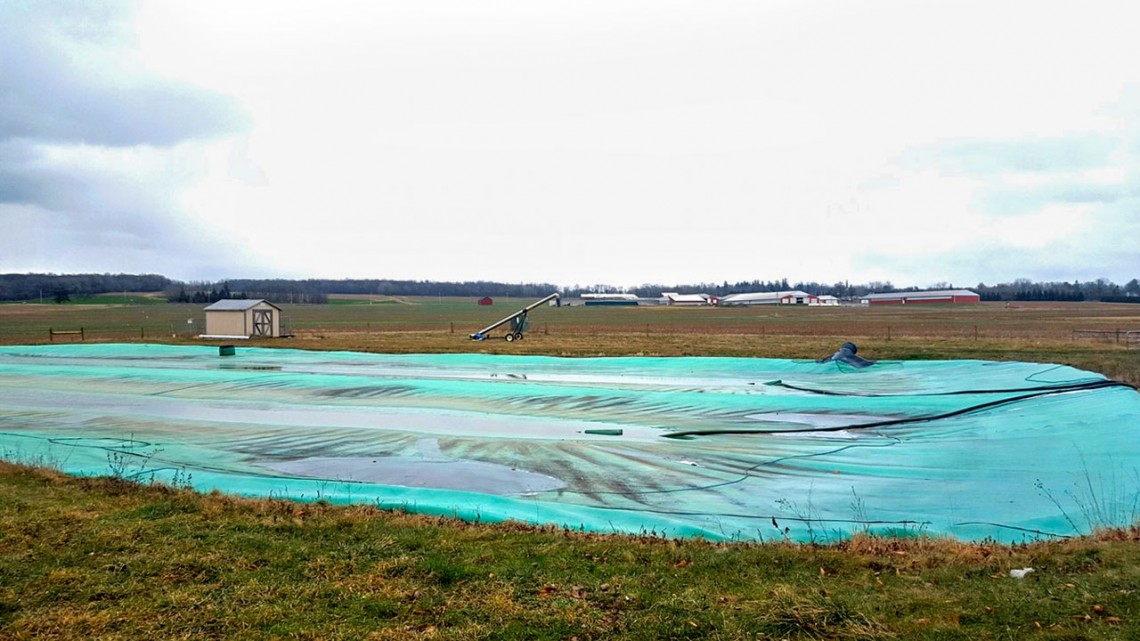
A manure cover and flare, pictured here on Fessenden Farm in King Ferry, New York, can improve water quality while also destroying methane.
Green practices can negate climate emissions on NY farms
By Krishna Ramanujan
New York agriculture has the capacity to mitigate its own greenhouse gas (GHG) emissions, two Cornell researchers say in a state-funded report commissioned by the New York State Department of Agriculture and Markets.
The 65-page report, New York Agriculture and Climate Change: Key Opportunities for Mitigation, Resilience, and Adaptation, provides a scientific assessment of opportunities and barriers supporting climate adaptation and mitigation practices on New York’s farms.
It comes on the heels of the Climate Leadership and Community Protection Act, which Gov. Andrew Cuomo signed into law last year. The law mandates that all sectors of society mitigate 40% of GHG emissions by 2030, and 85% by 2050.
“This report provides a pathway for farmers, policymakers and citizens to increase productivity and the greenhouse gas mitigation of the land while also attempting to ensure a less variable climate for future farmers,” said Jenifer Wightman, a research associate in the Soil and Crop Sciences Section of the School of Integrative Plant Science, in the College of Agriculture and Life Sciences, and the report’s first author.
“In an industrialized state like New York, we need every sector to step up and make a contribution to mitigating climate change,” said co-author Peter Woodbury, senior research associate in the Soil and Crop Sciences Section. “There’s the opportunity to do that with agriculture and forestry while also getting other benefits” such as improved profitability and cleaner air and water, he said.
Though people mostly focus on carbon emissions, the authors said it’s important to account for three greenhouse gases produced on farms: carbon dioxide, methane and nitrous oxide.
“It’s not commonly known, but methane and nitrous oxide account for 75% of agricultural emissions,” Wightman said, noting that methane is 84 times more potent than carbon dioxide as a GHG, and nitrous oxide is 264 times more potent, making them important mitigation targets.
The report identified practices that remove GHGs more permanently from the atmosphere, as opposed to temporary fixes. Planting trees, the researchers wrote, can sequester carbon for hundreds of years if harvested for building materials that store carbon for the life of the structure.
“Because climate change is a 100-, 300-, 1,000-year project,” Wightman said, “we want to make sure that we’re supporting projects that lead to permanent greenhouse gas emission reductions and aren’t just temporary.”
The report includes a table that ranks 13 mitigation opportunities based on the scale at which they could be implemented, and whether they met important criteria. These standards were summed up by the acronym SMART – for “services” or co-benefits of an action; whether a strategy is “measurable,” “achievable” and “realistic” to implement; and whether the action provides a more permanent mitigation “time” frame.
The top five SMART mitigation actions were:
- Manure storage cover and flare: Storage units improve water quality by reducing manure spreading in winter months, but they create methane. By adding a cover to collect the methane and adding a flare, the methane can be destroyed. These systems last up to 20 years, cost $300,000 and remove large amounts of methane making it an inexpensive GHG mitigation for society, though it is a high cost per individual farm;
- Nitrogen management: Nitrogen inputs help plants grow, but ineffective use results in nitrous oxide emissions. Improving nitrogen use saves money, can increase yields and reduce ammonia and nitrous oxide emissions;
- Livestock feed management: Increasing feed efficiency can reduce cow methane emissions, decrease feed costs while increasing milk produced and decrease manure, all of which lessens GHG emissions;
- Woodland management: More than 21% (approximately 1.4 million acres) of farmlands are wooded. By protecting, maintaining and managing woodlands, farms can conserve and enhance this important New York state carbon sink while generating valuable hard wood timber to support retirement or a child’s college education; and
- Activation of underutilized lands: About 1.7 million acres of underutilized or former farm land in New York state could be used for bioenergy production, solar arrays and/or growing new forests – all of which offer diverse mechanisms of GHG mitigation and rural economic development.
Wightman and Woodbury have also authored a companion report, “Sources and Sinks of Major Greenhouse Gases associated with New York State’s Natural and Working Lands: Forests, Farms, and Wetlands” (2020), commissioned by the New York State Energy Research and Development Authority.
Media Contact
Get Cornell news delivered right to your inbox.
Subscribe

